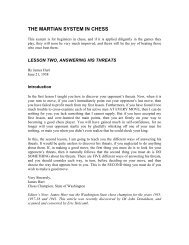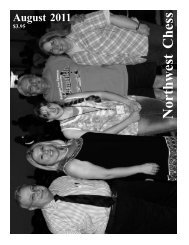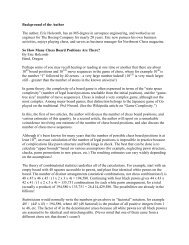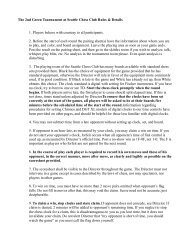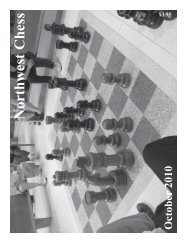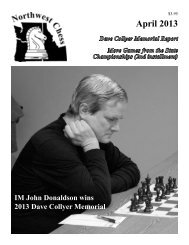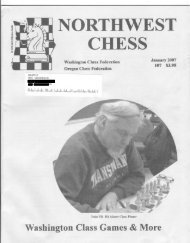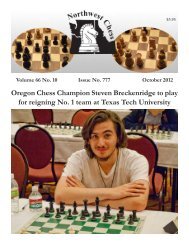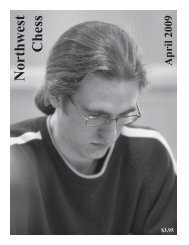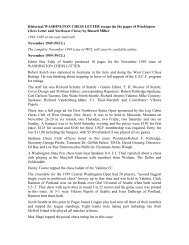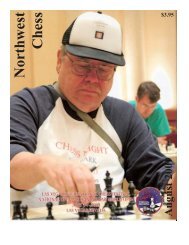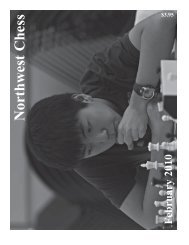January, 2012 - Idaho Chess Association
January, 2012 - Idaho Chess Association
January, 2012 - Idaho Chess Association
Create successful ePaper yourself
Turn your PDF publications into a flip-book with our unique Google optimized e-Paper software.
9...d5 10.h4<br />
Taking on d5 would have been more<br />
accurate.<br />
10...h5 11.£f2<br />
He probably did not consider ...e7-e5.<br />
11...e5 12.¤xc6 bxc6 13.exd5 cxd5<br />
14.¥g5 d4 15.¤e4 ¤xe4 16.fxe4 f6<br />
Maybe 16...£a5 or 16...£c7 would<br />
have been better.<br />
17.¥c4+ ¢h7 18.¥d2 f5 19.£e2<br />
fxe4 20.£xe4 ¥f5 21.£e2 ¥g4<br />
22.£e4<br />
XABCDEFGHY<br />
8r+-wq-tr-+(<br />
7zp-+-+-vlk'<br />
6-+-+-+p+&<br />
5+-+-zp-+p%<br />
4-+LzpQ+lzP$<br />
3+-+-+-+-#<br />
2PzPPvL-+P+"<br />
1+-mKR+-+R!<br />
xabcdefghy<br />
22...¦c8<br />
I decided not to take the Rook, because<br />
I preferred building up my army<br />
and preventing any counterplay. GM<br />
Nick De Firmian agreed with my choice<br />
in later analysis.<br />
23.¥d3 ¥f5 24.£f3 ¥xd3 25.<br />
£xd3 £d5 26.¢b1 e4 27.£a3<br />
Inaccurate. 27.£b3 would have<br />
been better.<br />
27...£c4 28.¦c1 ¦f2<br />
Here, I knew I won this game. He<br />
cannot hold out much longer under such<br />
pressure. In post-game analysis, my<br />
Orlov <strong>Chess</strong> Academy ad<br />
chess engine says I am up by four points,<br />
even though I am not up material.<br />
29. b3 £c7<br />
29...£e2 30.¦hd1 e3 31.¥xe3<br />
dxe3 is another possibility.<br />
30.¦hd1 e3 31.¥a5 £c6 32.c3<br />
£e4+ 33.¢a1 dxc3 34.¥xc3 ¦xc3<br />
0-1<br />
Since the game with Julian did not<br />
last very long, I had some time to relax<br />
before the second game of the day.<br />
When the pairings came out, and it turned<br />
out that I was to play a top player from<br />
Columbia, I became a little worried. After<br />
all, Acosta is a CM and has a FIDE<br />
rating of 1982. My dad did a quick online<br />
search and found a few of his games.<br />
We had about half an hour to prepare,<br />
and then we had to rush back to the conference<br />
center. As we had guessed, he<br />
played the Sicilian. We ended up playing<br />
the Sozin, which I like.<br />
B89 Sicilian Sozin<br />
Marcell Szabo (USA, 1676)<br />
Jorian Acosta Cubides (COL, 1982)<br />
Caldas Novas, World Youth U10 (4) 2011<br />
Annotations by Marcell Szabo<br />
1.e4 c5 2.¤f3 e6 3.d4 cxd4 4.¤xd4<br />
¤c6 5.¤c3 d6 6.¥c4 ¤f6 7.¥e3<br />
¥e7 8.h3<br />
This was a bit too cautious on my<br />
part.<br />
8...a6 9.¥b3 ¤xd4 10.¥xd4 b5 11.<br />
a3 ¥b7 12.£d3<br />
Guarding the e-pawn.<br />
12...¦c8 13.O-O O-O 14.¦fe1<br />
¤d7 15.£g3 ¤f6 16.¦ad1 £c7<br />
17.f4 ¤e8 18.f5<br />
I played this<br />
because, if he responds<br />
with<br />
...e6-e5, then the<br />
d5-hole is mine.<br />
1 8 . . . e 5<br />
19.¥f2 £d8<br />
20.¦e2 ¥f6<br />
When he<br />
picked up the<br />
piece, he intended<br />
to play<br />
20...¥h4, but he<br />
must have seen that it loses. He had to<br />
do something with his Bishop and that<br />
gave me additional momentum to develop<br />
and attack.<br />
21.¤d5 ¢h8 22.¦ed2 ¥g5<br />
Not a good move. It puts me in<br />
charge of the game. I think he was still<br />
mad at himself, because of what happened<br />
a couple of moves earlier, and lost<br />
some of his concentration. Here I figured<br />
out a little combination, which, in<br />
seven moves, should win a pawn for me<br />
and should put me in a good position.<br />
XABCDEFGHY<br />
8-+rwqntr-mk(<br />
7+l+-+pzpp'<br />
6p+-zp-+-+&<br />
5+p+NzpPvl-%<br />
4-+-+P+-+$<br />
3zPL+-+-wQP#<br />
2-zPPtR-vLP+"<br />
1+-+R+-mK-!<br />
xabcdefghy<br />
23.¥b6 ¤c7 24.¤xc7<br />
Another idea is 24.f6 ¥xf6 25.¤xc7<br />
¦xc7 26.¥xc7 £xc7, but I wanted to<br />
have a clear pawn advantage, rather than<br />
going up by an Exchange.<br />
24...¥xd2 25.¦xd2 ¦xc7 26.£d3<br />
I think this was the key move of my<br />
combination.<br />
26...¦c3 27.¥xd8 ¦xd3 28.cxd3<br />
¦xd8 29.¥xf7<br />
The combination worked; here is my<br />
bounty, a clear pawn. After that, as they<br />
say, it was just ‘a matter of technique.’<br />
29...¦f8 30.¥e6 ¥c8 31.¦c2<br />
¥xe6 32.fxe6 ¢g8 33.¦c6 ¦d8<br />
34.e7 ¦e8 35.¦xd6 ¦xe7 36.<br />
¦xa6 ¦c7 37.¦b6 ¦c5 38.¦b7 h6<br />
39.¢h2 ¢h7 40.¢g3 ¢g6 41.¢f3<br />
¢f6 42.¢e3 g6 43.d4 exd4+ 44.<br />
¢xd4 ¦g5 45.e5+ 1-0<br />
In post-game analysis, Nick De<br />
Firmian congratulated me on the game<br />
and noted that I had picked an elegant<br />
move to finish the game.<br />
The following game was especially<br />
important to me. This summer, while visiting<br />
my grandparents in Hungary, I<br />
Northwest <strong>Chess</strong> <strong>January</strong> 2011 5



